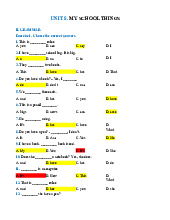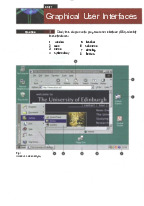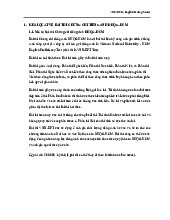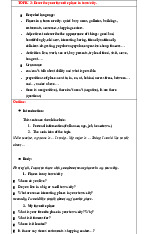







Preview text:
lOMoAR cPSD| 59285474 UNIT 13 The World Wide Web STARTER
Study this URL (Uniform Resource Locator).
http: //www. hw. ac. uk/libWWW/irn/irn. html protocol Web domain domain country directory document prefix name code path Fig 1 extension
Uniform Resource Locator
Which part of the address tells you: 1 the company is in the UK 2 this is the webpage
3 the type of transmission standard your browser must use to access the data
4 this points to the computer where the webpage is stored
5 this is where the webpage is stored in the computer 6 this is a company 7 this is a Web file
Study these approved domain name extensions and their
meanings. Then match these suggestions for new extensions to their meanings. Extension Meaning . aero aviation industry . biz businesses . com (. co in UK) commercial . coop cooperatives . edu(. ac in UK) educational and research . gov government . info general use . int international organisation . mil military agency . museum museums . name individuals . net gateway or host . org non-profit organisation . pro professionals lOMoAR cPSD| 59285474 Suggested extension Meaning 1 . firm a informative 2 . store b cultural or entertainment 3 . web c personal 4 . arts d firm or agency 5 . rec e online retail shop 6 . info f Web-related 7 . nom g recreational LISTENING
Study this diagram which il ustrates how your browser finds
the webpage you want. Label these items: a Router
b Domain Name System (DNS) server c Remote Web server d Browser PC e URL f Internet Protocol address Fig 2
How your browser finds the page you want lOMoAR cPSD| 59285474
90 UNIT 13 The World Wide Web
Now listen to this recording which explains how the
process works and take brief notes on each stage. For example: Stage 1
Click on a webpage hyperlink or URL.
The browser sends the URL to a DNS server. LANGUAGE WORK Time clauses
What is the relationship between each of
We can use once in place of when to these pairs of actions?
emphasise the completion of the first action. 1 a You click on a URL.
It often occurs with the Present perfect. For
b Your browser sends it to a DNS server. example:
2 a The packets are passed from router to
Once the DNS server has found the IP address, router.
it sends the address back to the browser. b They reach the Web server.
3 a The packets may travel by different
We can use until to link an action and the routes. limit of that action: b They reach the Web server.
2 The packets are passed from router to
4 a The individual packets reach the Web
router until they reach the Web server. server.
We can use before to show that one action
b They are put back together again. precedes another:
Each pair of actions is linked in time. We can
3 The packets may travel by different routes
show how actions are linked in time by using
before they reach the Web server. time clauses. For example:
If the subjects are the same in both actions,
We can use when to show that one action we can use a participle:
happens immediately after another action:
The packets may travel by different routes
1 When you click on a URL, your browser
before reaching the Web server. sends it to a DNS server.
We can use as to link two connected actions happening at the same time:
4 As the individual packets reach the Web
server, they are put back together again.
Link each pair of actions using a time clause. a You use a search engine.
b It provides a set of links related to your search.
a With POP3, email is stored on the server.
b You check your email account.
a You have clicked on a hyperlink.
b You have to wait for the webpage to be copied to your computer. lOMoAR cPSD| 59285474
92 UNIT 13 The World Wide Web PROBLEM-SOLVING
Search engines Study these tips for conducting searches
using AltaVista. Then decide what you would type into the search
box to find this data. Compare your answers with others in your
group and together decide what would be the best search. Restrict sites to English language.
Don't use simple keywords. Typing in
Apple or apPle, AltaVista will only match Apple and
the word football is unlikely to help apPle respectively.
you to find information on your
favourite football team. Unless special operators are
AltaVista supports natural language
included, AltaVista assumes the default operator is
queries. If you really aren't sure where
OR. If, for example, the search query is American
to start looking, try typing a natural
football, AltaVista will look for documents containing language query in the search box. The question
either American or football although it will list higher
Where can I find pages about digital cameras? will
those documents which contain both.
find a number of answers but at least it will give you some idea of where to start.
AltaVista is specifically case sensitive.
If you specify apple as your search
term, AltaVista will return matches
for apple, Apple and APPLE. However, if you use lOMoAR cPSD| 59285474 UNIT 13 The World Wide Web 93
Try using phrase searching. This is
You can refine your search by doing a
where you place quotation marks
field search. Put the field, then a colon
around your search term, e. g.
and then what you are looking for.
'alternative medicine'. This will search for all For example,
documents where these two words appear as a
URL: UK +universities will find only British phrase. universities.
title: 'English language' will find only sites which
Attaching a + to a word is a way of
contain this phrase in their titles.
narrowing your search. It means that word must be included in your
AltaVista supports the use of wildcard
search. For example, if you were looking for
searches. If you insert a * to the right
information on cancer research, use +cancer
of a partial word, say hydro*, it will r
+ esearch instead of just cancer.
find matches for all words beginning with hydro such
as hydrocarbon and hydrofoil. Wildcards can also be
Attaching a - to a word or using NOT
used to search for pages containing plurals of the
is another way of narrowing your
search terms as well as to catch possible spelling
search. This excludes the search item
variations, for example alumin*m will catch both
following the word NOT or the - sign. For example,
aluminium (UK) and aluminum (US).
science NOT fiction or science -fiction will exclude
sites in which these two words occur together.
If you are looking for multimedia files
then save yourself time by selecting Use brackets to group complex
images, audio or video with the radio
searches, for example: (cakes AND
buttons on AltaVista's search box and then entering
recipes) AND (chocolate OR ginger) your search.
will find pages including cakes and recipes and either chocolate or ginger or both.
1 a street map of Edinburgh, Scotland
2 train times between London and Paris
3 the exchange rate of your currency against the US dollar
4 a recipe for chocolate chip or hazelnut brownies 5 video clips of the Beatles
6 sumo wrestler competitions in Japan this year
7 the weather in New York city tomorrow 8 heart disease amongst women
9 New Zealand universities which offer courses in computing
10 Sir Isaac Newton's laws of motion
Test your answers using AltaVista. WRITING
Write your own description of how your browser finds the page
you want. Use Fig 2 to help you. When you have finished, compare
your answer with the listening script to Task 4 on page 198. lOMoAR cPSD| 59285474
94 UNIT 13 The World Wide Web Email Protocols
Find the answers to these questions in the
Although the format of a mail message, as following text.
transmitted from one machine to another, is
1 Name three different email protocols
rigidly defined, different mail protocols transfer mentioned in the text.
and store messages in slightly different ways. The
2 Which email protocol is used to transfer
mail system you're probably used to employs a
messages between server computers?
combination of SMTP and POP3 to send and
3 Why is SMTP unsuitable for delivering
receive mail respectively. Others may use IMAP4 messages to desktop PCs?
to retrieve mail, especially where bandwidth is
4 Name two host-based mail systems limited or expensive. mentioned in the text.
5 Where are email messages stored in an SMTP system?
SMTP is used to transfer messages between one
6 What happens when you use your Web mail
mail server and another. It's also used by email
account to access a POP3 mailbox?
programs on PCs to send mail to the server. SMTP
7 Give an advantage and a disadvantage of
is very straightforward, providing only facilities to
having an option to leave POP3 messages
deliver messages to one or more recipients in on the server.
batch mode. Once a message has been delivered,
8 What are the advantages of using the IMAP4
it can't be recalled or cancelled. It's also deleted protocol?
from the sending server once it's been delivered.
SMTP uses 'push' operation, meaning that the
connection is initiated by the sending server
rather than the receiver. This makes it unsuitable
Web mail systems use some of the same protocols as
client/server mail. Some can access an ISP-based POP3
for delivering messages to desktop PCs, which
mailbox, allowing you to read your mail anywhere you can
aren't guaranteed to be switched on at all times. find a browser. lOMoAR cPSD| 59285474
UNIT 13 The World Wide Web 95
In host-based mail systems, such as Unix and Web
mail, SMTP is the only protocol the server uses.
Received messages are stored locally and retrieved
Re-read the text to find the answers to
from the local file system by the mail program. In
0 these questions.
the case of Web mail, the message is then
1 Mark the following statements as True or
translated into HTML and transmitted to your False:
browser. SMTP is the only protocol for transferring
messages between servers. How they're then
a Different mail systems transfer emails in
stored varies from system to system. different ways.
b IMAP4 requires more bandwidth than the Post Office Protocol other email protocols.
POP is a message-retrieval protocol used by many
c SMTP is used for sending emails from a PC
PC mail clients to get messages from a server, to a server.
typically your ISP's mail server. It only allows you
d SMTP delivers messages one at a time.
to download all messages in your mailbox at once.
e SMTP does not allow a delivered message to
It works in 'pull' mode, the receiving PC initiating be cancelled.
the connection. PC-based POP3 mail clients can
f SMTP is only one of many protocols used to
do this automatically at a preset interval. When send mail between servers.
you use your Web mail account to access a POP3
g POP protocol allows the user to download
mailbox, the mail server opens a connection to one message at a time.
the POP3 server just as a PC-based application
would. The messages are then copied into your
2 Match the terms in Table A with the
Web mailbox and read via a browser. statements in Table B.
Since POP3 downloads all the messages in your Table A
mailbox, there's an option to leave messages on
the server, so that they can be picked up from a SMTP
different machines without losing any. This does b 'Push' operation
mean that you'll get every message downloaded c POP
every time you connect to the server. If you don't d 'Pull' operation
clean out your mailbox regularly, this could mean
long downloads. When using a Web mail account e IMAP
to retrieve POP3 mail, be careful about leaving
messages on the server - if too many build up. Table B
each download will take a long time and fill up
i An email transfer process in which the
your inbox. Many Web mail systems won't
connection is initiated by the sending
recognise messages you've already downloaded, so
computer rather than the receiving
you'll get duplicates of ones you haven't deleted. computer.
ii A mail transfer protocol that initially only
Internet Mail Access Protocol
IMAP is similar in operation to POP, but allows
retrieves the message headers.
you more choice over what messages you
iii An email transfer process in which the
download. Initially, only message headers are
receiving computer initiates the
retrieved, giving information about the sender and connection.
subject. You can then download just those
iv A simple mail transfer protocol that is
messages you want to read. You can also delete
used to send messages between servers.
individual messages from the server, and some
v A message-retrieval protocol that
IMAP4 servers let you organise your mail into
downloads all email messages at the
folders. This makes download times shorter and same time.
there's no danger of losing messages.
[ Adapted from 'Using Web-based Email' by Jonathan
Bennett, PC Magazine, November 1999]



